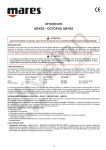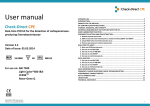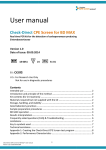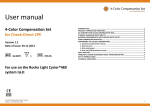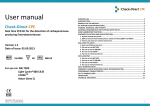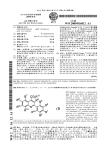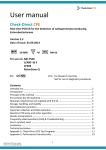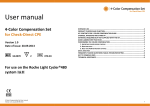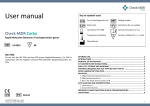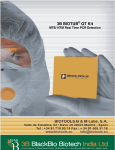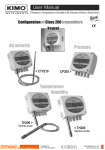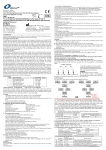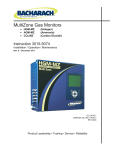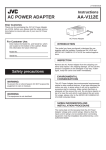Download User manual - Check
Transcript
User manual Check-Direct CPE for BD MAX MAX™ Real time PCR kit for the detection etection of carbapenemase carbapenemase-producing Enterobacteriaceae Version 1.3 Date of issue: 24.01.2014 18-0081 Check-Direct CPE for BD Max™ User manual Version 1.3, Issued 24-01-2014 48 081-04 INTENDED USE ................................................................ ....................................................................................2 INTRODUCTION AND PRINCIPLE NCIPLE OF THE METHOD ..............................................................2 KIT CONTENTS (FOR 48 REACTIONS) ...................................................................................2 ................................ STORAGE, HANDLING, AND STABILITY ................................................................................2 ................................ MATERIALS REQUIRED BUT UT NOT SUPPLIED WITH THE KIT...................................................2 GOOD LABORATORY PRACTICES .........................................................................................2 ................................ SPECIMEN AND CELL SUSPENSION SPENSION PREPARATION ..............................................................4 BD MAX™ SAMPLE AND CONTROL ONTROL PREPARATION ..............................................................4 1. SAMPLE PREPARATION .......................................................................................................... ................................ 4 2. POSITIVE AND NEGATIVE CONTROL PREPARATION ...................................................................... 4 BD MAX™ SYSTEM REAL-TIME PCR .....................................................................................4 ................................ 1. MULTIPLEX REAL-TIME PCR (QPCR) SETUP .............................................................................. 4 2. QPCR MIX PREPARATION ...................................................................................................... ................................ 4 3. CREATING THE CHECK-DIRECT CPE TEST .................................................................................. ................................ 4 4. BD MAX™ RACK SET-UP ...................................................................................................... ................................ 5 5. BD MAX™ INSTRUMENT SET-UP ............................................................................................ ................................ 5 BD MAX™ RESULTS ................................................................ .............................................................................6 1. HOW TO CREATE AND PRINT DATA REPORT ............................................................................... ................................ 6 2. ANALYSIS ................................................................ ............................................................................................ 6 3. INTERPRETATION ................................................................ .................................................................................. 6 FREQUENTLY ASKED QUESTIONS STIONS (FAQ) & TROUBLESHOOTING TROUB ..........................................7 LIMITATIONS ................................................................ .......................................................................................8 TECHNICAL ASSISTANCE ......................................................................................................8 ................................ KEY TO SYMBOLS USED .......................................................................................................8 ................................ 1 Intended use Check-Direct CPE is a qualitative in vitro diagnostic test for the rapid detection of carbapenemase genes KPC, VIM, OXA-48 and NDM, presently the primary cause of TM carbapenemase production in Enterobacteriaceae.. The assay is performed on the BD MAX system using bacterial cell suspension from clinical specimen of individuals at risk of colonization with carbapenemase-producing Enterobacteriaceae.. Check Check-Direct CPE is not intended to diagnose infections with carbapenemase-producing Enterobacteriaceae nor to guide or monitor treatment for these infections. Parallel cultures are necessary to recover organisms for epidemiological typing, susceptibility testing and for fur further confirmatory identification. Introduction and principle of the method The worldwide emergence and dissemination of carbapenem resistance among Enterobacteriaceae is a serious threat to public health. These organisms are associated with high mortality rates and have the potential to spread widely. The most common cause of carbapenem resistance in Enterobacteriaceae is the expression of carbapenemases, i.e. Carbapenemase-Producing Enterobacteriaceae or CPE. CPE have elevated or complete resistance to carbapenems and most other β-lactam lactam antibiotics. Presently, the vast majority of CPE are associated with the presence of one of the following plasmid plasmid-encoded carbapenemases: KPC (Klebsiella pneumoniae carbapenemase), VIM (Verona integron integron– encoded metallo-β-lactamase), NDM (New Delhi metallo-β-lactamase) lactamase) or OXA OXA-48 (Oxacillinase-48). Moreover, CPE often have other non–β-lactam lactam resistance determinants resulting in multidrug- and pandrug-resistant isolates. time PCR assay for detection of the KPC, OXA OXA-48, NDM Check-Direct CPE is a multiplex real-time and VIM carbapenemase genes. The assay is based on specific recognition and amplification of target sequences by PCR, and the simultaneous aneous detection of the accumulation of PCR amplification products by fluorescent DNA probes. Four molecular beacon probes labelled with four different dyes are used for the fluorescent detection and the disc discrimination of the carbapenemase markers.. For each of the 4 carbapenemase genes, KPC, VIM, OXA-48 and NDM,, many gene variants exist. PCR primers and fluorescent probes of Check Check-Direct CPE are selected to target homologous gene segments of these carbapenemase genes, and in this way all gene variants are reliably detected. Check-Direct CPE for BD Max™ User manual Version 1.3, Issued 24-01-2014 Kit contents (for 48 reactions) Components (Mat. No.) CPE solution (9-0072)* Negative control (9-0070) KPC positive control (9-0073) VIM positive control (9-0074) OXA-48 positive control (9-0076) NDM positive control (9-0075) User Manual (9-0079) Description Storage conditions 1 brown tube (blue inlay ) 550 μl 1 tube (white inlay ) 100 µl 1 tube (green inlay ) 100 μl - 20°C, store in the dark 1 tube (yellow inlay ) 100 μl 1 tube (orange inlay ) 100 μl 1 tube (gold inlay ) 100 μl Leaflet – download from website Not critical Storage, handling, and stability The Check-Direct CPE kit is shipped cooled and should be stored immediately at -20°C upon receipt. Store all opened reagents at -20°C 20°C until expiration date. Store in the dark. Please visually inspect the box upon initial opening to ensure that its contents content are intact. The CPE solution should not be exposed to more than 12 freeze-thaw cycles. Please contact the Check-Points office at [email protected] support@check if you have any further questions. Materials required but not supplied with the kit Supplies • • • • • • • • BD MAX™ ExK™ DNA-1 1 Extraction Kit (Ref:442818) BD MAX™ DNA MMK (SPC) Master Mix (Ref: 442829) BD MAX™ PCR Cartridges (Ref: 437519) Disposable laboratory (powder-free) free) gloves Lab coat Pipettes & disposable (filter-)) tips for volumes of 1 to 1000 µl DNAase free 1.5 ml tubes (1.5 and/or 2ml) PCR-grade water (e.g. Milli-Q) Equipment • • • Real-time PCR instrument: BD MAX™ System, software version 2.92 Vortex mixer Mini centrifuge 2 Good laboratory practices Recommendations for best results The quality of the results depends on strict compliance with the following good laboratory practices, especially concerning PCR practices. • • • • • • Users are strongly advise vised to read the full protocol before starting the test The test must be performed by adequately trained personnel. Do not use reagents after their expiration date Before use, thaw frozen reagents completely at room temperature and vvortex briefly to obtain a homogeneous solution. After vortexing briefly, spin down the solution to avoid contamination when opening the lid. Avoid unnecessary freeze freeze-thawing of the kit content. Follow recommendations for storage, handling and freeze-thaw thaw cycles to preserve the quality of the kit’s reagents. Protect reagents from light to avoid photo-bleaching bleaching of the dyes. Periodically, verify the accuracy and precision of pipettes, as well as correct functioning and calibration of the instruments. Prevention of contaminations Use separate rooms: a pre-PCR room and a post-PCR room. • • • Preparation of the amplification reactions are carried out in the pre pre-PCR room. DNA extraction and real-time PCR assays are carried out in the post post-PCR room. Never transfer items from the post-PCR room to the pre-PCR PCR room. To keep laboratory free of PCR product contamination: Use pipettes with hydrophobic filter tips. Make sure to always use a new pipette tip when adding solutions, test samples, and controls to a reaction tube to avoid contamination. • Follow proper pipette-dispensing dispensing techniques to prevent aerosols. • Wear clean disposable gloves and clean lab coats for the different steps of the test. • Change gloves whenever you suspect that they are contaminated. • Keep the tubes of all kit components and samples closed as much as possible. • Clean the lab benches and all equipment regularly with a 0,5% sodium hypochlorite solution. • • Check-Direct CPE for BD Max™ User manual Version 1.3, Issued 24-01-2014 3 Specimen and cell suspension preparation BD MAX™ system real-time time PCR • Inoculate nutrient agar plates with the clinical samples or the bacterial strains to be tested and incubate overnight at 37°C. Typical growth media include blood agar, MacConkey agar and Tryptic Soy agar. 8 • Prepare a bacterial cell suspension of McFarland 0.5 (≈1 x 10 CFU/ml) in cell suspension buffer (e.g. PBS or 10mM Tris HCl pH8.0) or PCR-grade water from bacterial cells grown 6 on the agar plate. Dilute the suspension 100 times mes to obtain a suspension of ≈1 x 10 CFU/ml. 1. Multiplex real-time time PCR (qPCR) setup BD MAX™ sample and control preparation Table 1 presents the multiplex qPCR setup with the targets detected in each detector channel of the BD MAX™ System. Table 1: Multiplex qPCR setup Detector 475/520 530/565 585/630 630/665 680/715 Channel 1 2 3 4 5 KPC VIM OXA-48 like NDM SPC* Target TM Important points before starting: Refer to the BD MAX™ ExK BD MAX™ System User’s Manual for detailed instructions. DNA DNA-1 kit user manual and 1. Sample preparation • After specimen collection, transfer the bacterial cell suspensions to be analyzed in the sample preparation area. 6 • Pipette 500 µL of the bacterial cell suspension (≈1 x 10 CFU/ml) into one DNA Sample Buffer Tube SB-1 (supplied by BD with the DNA extraction kit, refer to Material required but not supplied with the kit). • Close the Sample Buffer Tube with a septum cap and vortex 10 second at low speed. *SPC: Sample Preparation Control 2. qPCR Mix preparation 2.1 Calculate culate the number of reactions for the specimen and controls (maximum 24 samples in total in one run). ). Thaw reagents, mix well, spin down and keep on ice. 2.2 Prepare the qPCR reaction mix as described describe in Table 2 using the CPE solution provided in the Check-Direct Direct CPE kit and the BD diluent provided in the BD MAX™ DNA MMK (SPC) reaction kit. Multiply the CPE solution and the BD diluents solutions by the total number of reactions calculated, plus 10% surplus to ensure e that you have enough qPCR reaction mix for all reactions. Table 2: qPCR reaction mix 2. Positive and negative control preparation To validate the run, perform positive and negative control reactions for each Check Check-Direct CPE PCR run. The positivee and negative controls are supplied with the kit. • Positive control(s) Test the relevant positive control(s) provided in the kit. Pipette ette 10 µL of positive control (KPC (), VIM (), OXA () or NDM ()) and 500 µL of PCR-grade grade water into one Sample Buffer Tube. Vortex for 10 seconds. Positive controls may also be combined: add 10 µL of each positive control to be tested and 500 µL of PCR-grade grade water into one Sample Buffer Tube. Vortex for 10 seconds. • Negative control(s) 500 µL of PCRPipette 10 µL of the negative control (solution ) provided in the kit and 50 grade water into one Sample Preparation Reagents tube. Vortex for 10 second seconds. Check-Direct CPE for BD Max™ User manual Version 1.3, Issued 24-01-2014 Component BD Primer and Probe Diluent (12.5X) CPE solution () Total volume for 1 strip Volume per reaction strip 2 µl 10,5 µl 12,5 µl 3. Creating the Check-Direct Direct CPE test Important points before starting: Refer to BD MAX™ System User’s Manual for detailed instructions on how to operate the BD MAX™ System and software v2.92. Skip step 3. if a PCR test program has already been created for the Check-Direct Check CPE test. parameters 3.1 Create a new Test, select Create test,, and enter the following parameters: • Test Name: type Check-Direct CPE • Extraction Type: select Exk DNA-1 4 • • • • • Master Mix Format: choose Type 2 MMK (SPC),, Probes/Primers Add M Manually Channel detector Settings: set Gain and Threshold with parameters presented in Table 3 GardRail: select Default Test details: enter the PCR profile, see Table 4 Spectral Cross Talk tab: enter parameters presented in Table 5 Table 3: Gain parameters. Detector 475/520 530/565 585/630 630/665 680/715 Gain 40 80 30 80 40 4.2. Prepare Unitized Reagents Strips: 4.2.a Snap the appropriate DNA extracti raction Reagent tube (white cap) into positions 1 into the DNA Strip, see Figure 1. 4.2.b Snap in a DNA MMK (SPC) Master aster Mix tube (green/yellow cap) into position 2 of the DNA strip, see Figure 1. 4.2.c Snap a Conical Tube into position on 3 (Figure 1). Pipette 12.5 µl of qPCR mix (Table 2) into the Conical nical Tube in position 3. Avoid bubbles and make sure the liquid is at the bottom of the tube. Threshold 100 150 200 300 300 Table 4: Real-time protocol parameters. Step Name Denaturation Step Name Amplification &Detection Profile Type Hold Profile Type 2 - temperature Cycles 1 Cycles 45 Time (s) Temp(°C) 600 98 Time (s) Temp(°C) 15 98 62 60 Detect NO Detect NO YES Figure 1: DNA Unitized Reagent Strip setup. Table 5: Spectral cross-talk parameters. 475/520 530/565 Excitation 585/630 Channel 630/665 680/715 False Receiving Channel 475/520 530/565 585/630 630/665 680/715 0.0 0.0 0.0 0.0 0.0 0.0 0.0 0.0 7.4 0.0 0.0 0.0 0.0 0.0 0.0 0.0 0.0 4.4 3.2 Select Save Test. 4. BD MAX™ Rack set-up 4.1. Load the BD MAX™ ™ system racks with the number of DNA Unitized Reagents Strips necessary for the number of samples to test. Gently tap each strip to make sure all liquids are at the bottom of their container. Check-Direct CPE for BD Max™ User manual Version 1.3, Issued 24-01-2014 5. BD MAX™ instrument set-up 5.1 Open the Run screen of the BD MAX™ System software v2.92. 5.2 In the Assay menu select Check-Direct Direct CPE. CPE 5.3 Enter the Sample Preparation reagent nt tube tu barcode using the barcode scanner (you can also enter the barcode manually). Start with position 1 of rack A. 5.4 Place each of the Sample Buffer Tubes ubes in their corresponding position in the BD MAX™ racks (with septum cap). 5.5 .5 Enter the specimen or patient identification information into the work list. Check that each specimen or patient information correspond to its specific Sample Buffer Tubes in the Rack. 5.6 .6 Load the Rack(s) into the BD MAX™ System. (Rack A is positioned on the left side of the instrument and Rack B on the right side). 5.7 Load the BD MAX™ PCR cartridge(s). 5.8 Close the instrument door and select Start Run. Run 5 BD MAX™ Results Important points before starting: For a detailed description on how to analyze data, refer to BD MAX™ System User’s manual. Always visually inspect the amplification plot for each sample tested versus CT values obtained with the software. 1. How to create and print data report 1.1 In the main menu, select Results and double click on the run to be analyzed. 1.2 Select the Run to analyze. 1.3 In the Print tab select the box for Results Protocol Details and PCR. 1.4 Select create report. The report can be saved as pdf file format. To print it select Print Report. Valid run reports: • No BD MAX™ System failures during the run • Positive controls with a CT value for the carbapenemase targets and sample processing control (SPC) as depicted in Table 6. • Negative control with a CT value of -1 1 in channel 1 (475/520), 2 (530/565), 3 (585/630) and 4 (630/665) and a CT value of 29 2 ±3 for the sample processing control (SPC) in channel 5 (680/715). Table 6: Criteria for a valid run with Check-Direct Direct CPE test. CT 475/520 KPC CT 530/565 VIM CT 585/630 OXA-48 like CT 630/665 NDM CT 680/715 SPC Positive controls 32 ±3 30 ±3 29 ±3 31 ±3 29 ±3 Negative sample -1 -1 -1 -1 29 ±3 Sample Type* * If observed CT values vary significantly from expected CT C values , see FAQ and Troubleshooting section 2. Analysis The BD MAX™ software reports CT values and amplification curves for each detector channel of each specimen tested in the following way: • CT value of 0 indicates that there was no CT value calculated by the software. Amplification curve of the sample showing a “0” CT value must be checked manually. • CT value of -1 indicates that no amplification process has occurred. Check that there is no amplification curve for the sample with a CT value of -1 on the graphical results results. • Any other CT value should be interpreted in correlation lation with the amplification curve (PCR Analysis tab) and according to the interpretation method, see Table 66-7 3. Interpretation 3.1 Run validation Verify that the real-time time PCR run is valid before data interpretation of the results. Check that there is no report of BD MAX™ System failure. Check the positive and negative control amplification curves. Table 6 shows criteria for a valid real-time time Check Check-Direct CPE run on the BD MAX™ System. Expected CT values for the positive and the negative controls are given as an indication not a definitive result. These values will depend on the threshold set by the software software. If the controls CT values are not as expected ected refer to FAQ and Troubleshooting “3”. Check-Direct CPE for BD Max™ User manual Version 1.3, Issued 24-01-2014 3.2 Results interpretation If the run has been validated, interpret nterpret results as positive, negative or invalid with the CT values obtained for the samples following ing the t guidelines outlined below and summarized in Table 7. • Positive carbapenemase samples will show a CT value in channel 1 (475/520), 2 (530/565), 3 (585/630) and/or 4 (630/665). (630/665) Positive carbapenemase samples will also show a CT value for the SPC in channel 5 (680/715). • Negative carbapenemase samples will show no CT value in channel 1 (475/520), 2 (530/565), 3 (585/630) and 4 (630/665). In channel 5 (680/715) a CT value for the SPC is expected of 29 ±3. • Samples with carbapenemase target CT of -1, and with a SPC showing no CT value or a CT ≥ 32 means that the assay is not ot valid and should be repeated, repeated see FAQ and Troubleshooting 3 to 6. Table 7: Data interpretation guidelines. KPC, VIM, OXA, NDM CT values SPC CT values alues Interpretation YES YES Positive sample -1 29 ±3 Negative sample -1 -1 or >32 Invalid 6 Frequently asked questions (FAQ) & Troubleshooting Refer to “the troubleshooting” section of the BD MAX™ System User’s Manual for additional information 1. 2. 3. Real-time results show no CT values or interpretation indicating that the sample is invalid. Possible causes and troubleshooting: • The PCR reaction has been inhibited by exogenous or endogenous substances. Please repeat sample testing. • The sample tested with Check-Direct Direct CPE is negative and the internal control was not amplified. • The DNA extraction failed since the SPC was not detected. • CPE Solution or The BD MAX™ DNA MMK (SPC) PCR mix was not added to the assay. Please repeat the test. • The BD MAX™ DNA MMK (SPC) PCR mix may have expired. • A error in liquid handling has occurred: check unitized reagent strips and microfluidic cartridge to determine where liquid handling problem has occurred (example: air bubble in the cartridge) and re-run run the sample. If the problem persists, contact your local BD representative. Troubleshooting for invalid results. For Invalid results: Repeat test with the original specimen by preparing a new Sample Buffer Tube. Alternatively, test newly collected specimen. Real-time results show no CT values for the positive control or interpretation indicating that sample is invalid? Possible causes and troubleshooting: • The positive control solution was not added. • qPCR reaction mix (CPE Solution with Primer/Probe Diluent) was not added to the assay. Please repeat the test. • The BD MAX™ DNA MMK (SPC) PCR mix was not added or may have expired. Check-Direct CPE for BD Max™ User manual Version 1.3, Issued 24-01-2014 4. flu signals in all samples and detector Real-time results show very low fluorescent channels, including the internal control signal. Possible causes and troubleshooting: • The CPE solution containing the fluorescent probes and primers is degraded. Please check expiration date,, the number of thaw/freezing cycle that the CPE solution tube has undergo, and if the kit has been stored correctly. • The BD MAX™ System ystem can be responsible respons for these results. Please refer to BD MAX™ User’s manual ual or contact your BD local representative. 5. ystem states an error or failure. The BD MAX™ System Refer to the BD MAX™ instrument user manual or contact your BD local representative. 6. All amplification curves show a spike at the same point in time. A problem with the power supply may have occurred. Verify that the system is correctly connected to its un-interruptible interruptible power supply and repeat experiment. 7. I have left Solutions (CPE or Positive ive control) out of the -20°C (-4˚F) storage. These reagents must be stored at -20°C 20°C (-4°F) ( for proper performance of the test. The performance of the product cannott be fully guaranteed if these solutions were left out of -20°C (-4˚F) for more than 24 hours. s. 8. Duplicate samples tested with Check-Direct CPE test do not yield identical results. CT values of identical samples may vary var between individual reactions. Large variations, > 2 CT values, suggest pipetting errors erro or other differences between the duplicate samples. 7 Limitations Check-Direct Direct CPE uses a range of specific DNA markers to detect the presence of the carbapenemase genes KPC, NDM, OXA-48, 48, and VIM, which currently represent the clinically most prevalent carbapenemases.. The test detects all presently known variants of KPC, NDM, OXA-48 and VIM, except VIM-7, 7, a rare variant only found in Pseudomonas aeruginosa.. It should be noted that other rare carbapenemase gene families are not detected. Check-Direct CPE was developed for bacterial cell suspension.. The quality of the input DNA is an important factor for obtaining reliable results with Check-Direct Direct CPE. DNA must be extracted from bacterial cell suspension validated with Check-Direct Direct CPE and d described in this manual. The assay has been tested extensively with purified DNA from gram gram-negative bacteria, such as Escherichia, Salmonella, Klebsiella, Enterobacter Enterobacter, Citrobacter and Pseudomonas,, with excellent results. However, it may never be excluded that other Gram Gramnegative bacteria eria or certain strains of the above species will yield poor results. Check Check-Direct CPE cannot and does not make any representation or warranty that it is capable of correctly detecting the carbapenemase genes in all gram-negative negative species, subspecies or typ types or in all clinical sample source. Results may need to be confirmed by additional methodologies in specific cases (e.g. for regulatory samples). Due to the high variability of bacterial genomes it is possible that certain subtypes might not be detected. Thee test reflects the state of knowledge of Check-Points Health B.V. The presence of multiple bacterial species in a sample may hamper the interpretation of the test. As with other diagnostic assays, the results of this test may only be interpreted in combination nation with additional laboratory and clinical data available to the responsible person. Use of this assay is limited to appropriately qualified personnel, well well-trained in performing DNA-based molecular detection methods. Key to symbols used For In Vitro Diagnostic Use Negative control Catalog number KPC positive control Batch code VIM positive control IFU number NDM positive control OXA-48 positive control CPE solution Consult instructions for use Temperature limitation Use before YYYY-MM Manufacturer Contains sufficient for < n > tests Despite the utmost care in the development and preparation of the protocol Check-Points Check cannot take any responsibility for errors, omissions and/or future changes herein. Literature Citation:: When describing a procedure for publication using this product, please refer to it as the CheckDirect CPE. Notice to Purchaser: This product is sold under license from PHRI Propertie erties and may be used under PHRI Properties patent rights only for human in vitro diagnostics, food testing, veterinary testing, or research. research Dye & quencher compounds in this product are sold ld under u license from Biosearch Technologies, Inc. and protected by U.S. and world-wide wide patents either issued or in application. The license grant g covers human in vitro diagnostic (IVD) applications Trademarks BD, BD MAX™ are trademarks Becton Dickinson GmbH Technical assistance [email protected] +31 317 453 908 Check-Points Health BV Binnenhaven 5 6709 PD Wageningen The Netherlands Check-Direct CPE for BD Max™ User manual Version 1.3, Issued 24-01-2013 Tel: +31 317 453 908 Fax: +31 317 210 147 [email protected] www.check-points.com 8










